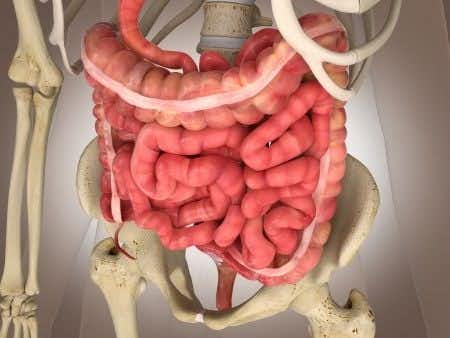A Utah-based plaintiff was in his 30s and had a history of chronic back pain from a previous fall from a roof. He previously underwent back surgeries. The procedure at issue in this case was considered minimally invasive and involved the placement of screws and a metal brace in and around the fifth lumbar and first sacral vertebrae. Access to this area is achieved via a paracoccygeal incision with retro-rectal space being developed bluntly.
In the recovery room, plaintiff developed bright red bloody stool, which raised the concern of a possible rectal injury. The surgeon contacted another surgeon by phone. He recommended a gastrografin enema. This showed a rectal wall leak into the presacral cavity. Plaintiff was placed on antibiotics. He later was given a percutaneous drain. Plaintiff did not receive his first dose of antibiotics until more than a day after the consulting surgeon prescribed it.
Plaintiff initially did well on discharge but later developed stool out of his gluteal wounds as well as out of the drain. A sinogram revealed a persistent defect in the posterior wall of the rectum with fecal spillage. He subsequently underwent a laparoscopic loop sigmoid colostomy, which he had for 10 months.
He filed a negligence case against his initial surgeon and the consulting/follow-up surgeon.
Question(s) For Expert Witness
1. Did the consulting surgeon breach the standard of care?
2. Why was his treatment reasonable?
Expert Witness Response
Based on my review of the extensive medical records and the depositions of the defendant doctors, I have reached the opinion that, to a reasonable degree of medical certainty, the care rendered to plaintiff by the consulting surgeon did not deviate from the standard of care for the following reasons:
The care and treatment of iatrogenic injuries to the colon and rectum is quite diverse and is influenced by numerous factors. Treatment options include conservative management ranging from observation to simple incision and drainage as well as a percutaneous drain placement, usually with administration of prolonged antibiotics. While once commonplace, more aggressive treatments including emergency resection with or without proximal diversion, Hartmann's procedure, and wide drainage via the abdomen and/or perineum, have been replaced by more conservative options in most patients showing no immediate signs of sepsis. The efficacy of more conservative management has been shown in numerous studies. The initial plan of care for plaintiff’s injury included a thorough radiographic examination to determine the extent of injury as well as the administration of broad-spectrum antibiotics suitable to treat the flora of the gastrointestinal tract. Additionally, close monitoring of his clinical course as well as his laboratory values was carried out by the consulting doctor and his team.
Factors important in deciding the optimal plan of care include, but are not limited to, the mechanism and extent of the initial injury, the potential for worsening injuries based on the mechanism of injury, the overall fitness of the patient, and the clinical course. An unexpected change to the clinical course mandates constant monitoring with an alteration in the plan of care as warranted. Often times this requires more aggressive care based primarily on concerns of the clinical exam as well as radiologic and laboratory findings. The early response to the initial plan of care was quite favorable. As plaintiff’s clinical course later deteriorated, additional measures were taken in a very appropriate and timely fashion. This included a bedside drainage of his gluteal abscess, modification of his antibiotic regimen, continued radiographic monitoring revealing a promising early improvement on follow-up CAT scan, and, later the placement of a loop sigmoid colostomy and a distal washout of the rectum, mainly to mitigate the fecal drainage from the gluteal wound not for a concern of sepsis, as plaintiff at that time point, was afebrile and had a normal white blood count. It is my opinion that the timing of the loop sigmoid colostomy as well as the inclusion of a distal washout of the rectum were not only well-timed but also well performed.
Of additional interest, and while quite difficult to fully ascertain, it is my opinion that the initial contamination of the lumbosacral metal implants occurred at the time of the initial injury. While immediate diversion may have decreased the level of contamination, it would not have eliminated it. Additionally, the decision to forego such aggressive therapy appears to have been warranted at that time based on the clinical scenario as well as radiographic findings. As it stands, whatever the degree of presumed initial contamination, there is currently no evidence of implant infection and associated osteomyelitis. The course of defendant consulting surgeon’s treatment achieved its goal and was successful.
About the author
Kristin Casler
Kristin Casler is a seasoned legal writer and journalist with an extensive background in litigation news coverage. For 17 years, she served as the editor for LexisNexis Mealey’s litigation news monitor, a role that positioned her at the forefront of reporting on pivotal legal developments. Her expertise includes covering cases related to the Supreme Court's expert admissibility ruling in Daubert v. Merrell Dow Pharmaceuticals Inc., a critical area in both civil and criminal litigation concerning the challenges of 'junk science' testimony.
Kristin's work primarily involves reporting on a diverse range of legal subjects, with particular emphasis on cases in asbestos litigation, insurance, personal injury, antitrust, mortgage lending, and testimony issues in conviction cases. Her contributions as a journalist have been instrumental in providing in-depth, informed analysis on the evolving landscape of these complex legal areas. Her ability to dissect and communicate intricate legal proceedings and rulings makes her a valuable resource in the legal journalism field.



